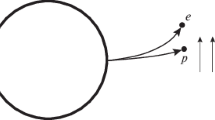Abstract
How regular magnetic fields in a plasma originated and are sustained is a question of considerable interest, since various objects in space such as spiral arms of galaxies, many stars, and planets have a regular magnetic field [1–3]. Several theoretical studies have been devoted to this theme [4–9]. However, because of the severe mathematical difficulties which arise in solving this problem, its study in the general form is still not possible, and its kinematic aspects are usually considered. In [5] a study is made of the induction of a toroidal magnetic field from the dipole field of a rotating spherical mass under the influence of radial convection. For the process to be undamped it is necessary to maintain a poloidal field, which according to the Cowling theorem may be induced by asymmetric motions from a toroidal field. Parker [6] suggested a specific model for the field increase by motions of the cyclonic type and indicated the possibility of self-regulation of the field maintenance process. Under certain conditions this process has a wave nature, the so-called “dynamo-waves.” In [7, 8] Braginskii considered the question of maintaining a quasi-stationary field by motions of the medium which differ little from axisymmetric motions. As a result of the large magnetic Reynolds numbers Rem≫1 the field decays slowly, and a weak generation mechanism is adequate for maintaining the field.
In [9] Birman and Schlüter suggested a fundamentally new mechanism for the formation of magnetic fields in a plasma as a result of the appearance under certain conditions of a vortical component of the mechanical electromotive force. It appears that this mechanism may be the reason for the appearance of cosmic magnetic fields.
In the present paper we make a detailed study of the Birman mechanism for the origin of magnetic fields, and we derive the conditions which are imposed on the motion and the characteristics of the completely ionized plasma which are necessary for the appearance of a vortical emf. It is shown that in this case the axisymmetric motions of a highly conducting plasma may generate toroidal magnetic fields of considerable magnitude. Further, a kinematic solution is given of the problem of the determination of the magnetic field and currents which arise in the spherical plasma volume modeling a star. This volume rotates about some axis with a given angular velocity Ω which depends on the spherical coordinates R and ϑ. Characteristics corresponding to the mean characteristics of the sun model are taken for specific calculations.
Similar content being viewed by others
References
S. B. Pikel'ner, Fundamentals of Cosmic Electrodynamics [in Russian], Nauka, 1966.
H. W. Babcock, “Magnetic fields of the A-type stars”, Astrophys. J. vol. 128, no. 2, 1958
S. Chandrasekhar and E. Fermi, “Magnetic fields in spiral arms”, Astrophys. J., vol. 118, no. 1, 1953.
W. Elsasser, “Magnetohydrodynamics”, Usp, fiz. nauk, vol. 64, no. 3, 1958.
E. C. Bull'ard, “Electromagnetic induction in a rotating sphere”, Proc. Roy. Soc., ser A, vol. 199, no. 1059, 1949.
E. N. Parker, “Hydromagnetic dynamo models”, Astrophys. J., vol. 122, no. 2, 1955.
S. I. Braginskii, “On self-excitation of a magnetic field with motion of a highly conductive liquid”, ZhETF, vol. 47, no. 3, 1964.
S. I. Braginskii, “Magnetohydrodynamics of the earth's core”, Geomagnetizm and aeronomiya, vol. 4, no. 5, 1964.
A. Schlüter and L. Birman, “Interstellar magnetic fields”, collection: Problems of Modern Physics [Russian translation], no. 2, 1954.
S. I. Braginskii, “Transport phenomena in a plasma”, collection: Problems of Plasma Theory, no. 1, Moscow, Gosatomizdat, 1963.
N. Ye. Kochin, I. A. Kibel, and N. V. Roze, Theoretical Hydromechanics [in Russian], 6th edition, Fizmatgiz, Moscow, 1963.
M. Schwarzschild, Structure and Evolution of the Stars [Russian translation], Izd-vo inostr. lit., Moscow, 1961.
H. W. Babcock, “The topology of the sun's magnetic field and 22-year cycle”, Astrophys. J., vol. 133, no. 2, 1961.
E. N. Parker, “The formation of sunspots from the solar toroidal field”, Astrophys. J., vol. 121, 1955.
J. W. Roxburgh, “On stellar rotation”, II, Monthly Notices, Roy. Astron. Soc., vol. 128, no. 3, 1964.
Author information
Authors and Affiliations
Rights and permissions
About this article
Cite this article
Yavorskaya, I.M. Certain problems concerning the origin and maintenance of cosmic magnetic fields. Fluid Dyn 3, 1–5 (1968). https://doi.org/10.1007/BF01019182
Issue Date:
DOI: https://doi.org/10.1007/BF01019182




